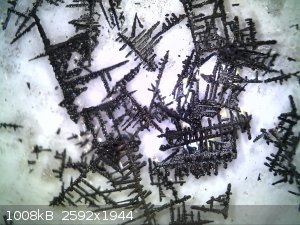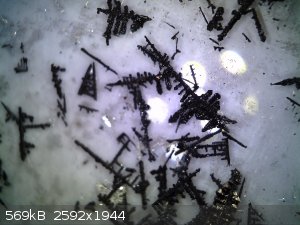
diddi - 22-12-2017 at 15:45
I digested about 50g of 925 silver scrap in hot conc. HNO3 producing a pale blue green solution. The solution was then used to set up a cell to
recover the Ag. The cathode was pure silver wire and the anode was pure graphite rod. The cell was powered by a current controlled variable voltage
power supply running at 2.6v and no more than 200ma
At the cathode, dendritic Ag soon began to form which was as expected.
The reason for my post today is to seek opinions on the product at the anode. There was continuous gas emission, but a crystalline product formed as
per the picture which i am at a loss to explain.


the crystals are hard but brittle and lustrous. the terminations in places appear to resemble the mineral cuprite (Cu2O) but i cannot see how this
could be the case as Cu2+ to Cu+ would have to occur by reduction not oxidation.
diddi - 23-12-2017 at 17:14
I have read that it is possible that the anode reaction may be Ag -> Ag+ + e- . Also I neglected to mention that the electrolysis was undertaken
in highly acidic conditions.
unionised - 24-12-2017 at 05:21
AgO is just about possible.
https://en.wikipedia.org/wiki/Silver(I,III)_oxide
If you heat the mystery crystals do they decompose + give silver?
diddi - 25-12-2017 at 01:52
I can check for decomposition on heating. At this stage they are microcrystals. Up to about 8-10mm long but i do have enough for destructive testing.
unionised - 25-12-2017 at 05:02
It also might be some sort of graphite oxide; be careful heating it.
